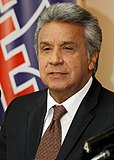Ecuadorian general election, 2017
|
|
||||||||||||||||||||
|
||||||||||||||||||||
|
||||||||||||||||||||
|
||||||||||||||||||||
General elections were held in Ecuador on 19 February 2017 alongside a referendum on tax havens. Voters elected a new President and National Assembly. Incumbent President Rafael Correa of the PAIS Alliance was not eligible for re-election, having served two terms. In the first round of the presidential elections, PAIS Alliance candidate Lenín Moreno received 39% of the vote. Although he was more than 10% ahead of his nearest rival, Guillermo Lasso of the Creating Opportunities party, Moreno was just short of the 40% threshold required to avoid a run-off. As a result a second round will be held on 2 April.
With Correa ineligible for re-election, his supporters formed an organisation Rafael Contigo Siempre (Always with you Rafael) to campaign for a constitutional amendment to allow him to run again. With signatures from 8% of the electorate required to hold a referendum (929,062), a total of 1.2 million were collected. However, Correa stated that he was planning on retiring from politics and would not run again. Instead, on 2 October 2016 the PAIS Alliance nominated Lenín Moreno, Correa's vice president from 2007 to 2013, as its candidate, with incumbent vice president Jorge Glas as his running mate.
The President is elected using a modified two-round system, with a candidate required to get over 50% of the vote, or get over 40% of the vote and be 10% ahead of their nearest rival to be elected in the first round.
The 137 members of the National Assembly were elected by three methods; 116 were elected in single-member constituencies using first-past-the-post voting, 15 were elected from a nationwide constituency using proportional representation, with six elected from three two-member constituencies representing Ecuadorians living overseas. Voting was compulsory except for voters aged 16–18 or over 65 and people classed as illiterate.
...
Wikipedia


